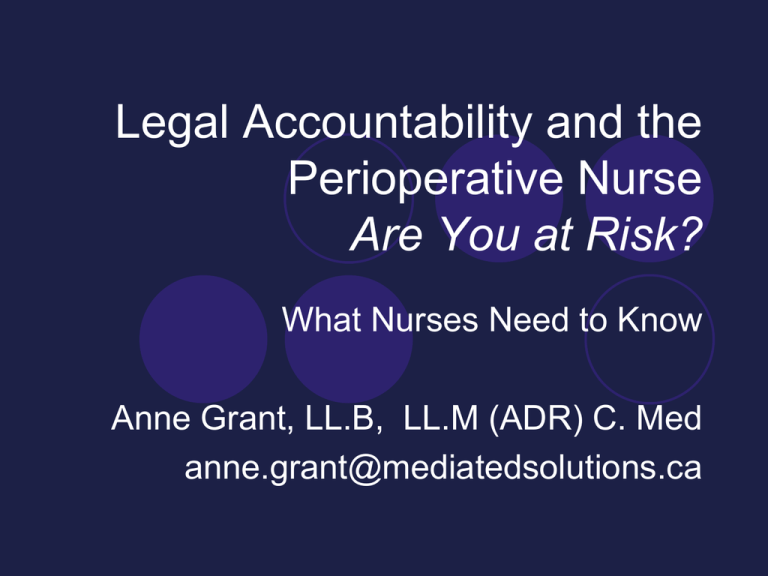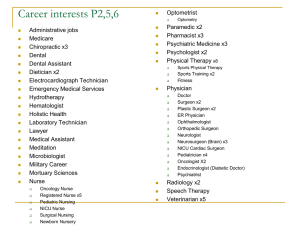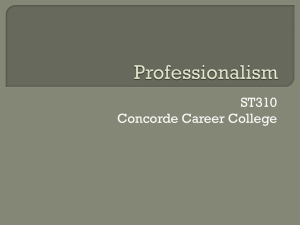ORNGT Legal Issues Feb 3 2015 Presentation Anne Grant
advertisement

Legal Accountability and the Perioperative Nurse Are You at Risk? What Nurses Need to Know Anne Grant, LL.B, LL.M (ADR) C. Med anne.grant@mediatedsolutions.ca Today we’ll discuss… Common legal pitfalls in Perioperative Nursing Sources of accountability Recent developments How to analyze your legal risk How to reduce your legal risk Legal Pitfalls Lack of understanding of sources of accountability Inadequate or absent documentation Breach of Confidentiality Absence of client consent Inconsistent Practice Sources of Legal Liability Employment Related Professional Liability to Regulatory Body (CNO) Civil Liability: Direct Vicarious Criminal Liability Employment Related Accountability Statutory Contractual Organizational policy and Procedure Recent Development – newly amended Occupational Health & Safety Act – June 15th, 2010 Violence in the Workplace: The Murder of Lori Dupont On November 12, 2005, Dr. Marc Daniel stabbed nurse Lori Dupont to death in the hospital where they both worked before injecting himself with a lethal dose of drugs. The MD had pursued her relentlessly over the previous year, eventually persuading her to go out with him Violence in the Workplace: The Murder of Lori Dupont The 2007 Coroner’s Inquest recognised that Dr. Daniel, who had been harassing Ms Dupont at work, exhibited three warning signs of lethal violence: clinical depression, attempted suicide and recent separation from his domestic partner Key Changes Bill 168 took effect June 15, 2010 Adds workplace violence and workplace harassment provisions to Ontario OHSA Extends the right to refuse work where worker believes “workplace violence is likely to endanger himself or herself” Requires employers to protect workers against “persons” (such as customers, patients, members of the public) other than workers who could cause physical injury to a worker Raised Awareness of Escalating Behaviours: Irritating Annoying Disruptive Intimidating Bullying Verbal Aggression Physical Aggression Violence Civil Liability Enforced primarily through legal action in the civil courts Applies Standard of care, i.e. the “Reasonable Nurse” For Example, requirement for Ontario Hospitals to use the WHO Surgical Checklist effective – April 1st , 2010 Common law standard of the reasonable health professional Regulatory (professional) standards & guidelines Institutional practices, polices & procedures Type of clinical area Size, location & type of institution Time frame of the alleged incident Current industry standards, trends Reasonable Foreseeability Analyze Your Legal Risk Do these circumstances attract liability? What standards apply? Action steps? If no action is taken will anyone be harmed? Documentation? Presence of Third Parties in OR Typically includes: Representatives of manufacturers of surgical equipment Students Presence of Third Parties in OR For example, an individual may request to observe a surgical procedure for personal or other reasons unrelated to patient care or safety. In these circumstances, issues such as patient privacy and autonomy exist. Patient safety concerns may arise if that person turns out to be a source of distraction or not properly instructed about the rules and procedures of the hospital and OR. Presence of Third Parties in OR Before permitting persons not a part of the surgical team to be present in the operating room, it is important to consider many issues, including patient privacy and confidentiality, consent, and safety. CMPA December 2008 Presence of Third Parties in OR In the US there have been a few court decisions as to whether liability can attach to medical device or pharmaceutical companies for the actions or omissions of their company representatives who are present in the operating room. Kennedy v. Medtronic (Illinois 2006) This case involved a death resulting from the cardiac physician’s installation of a Medtronic-manufactured pacemaker into the wrong side of the patient’s heart. Medtronic supplied a clinical specialist who attended the surgery and checked the leads to ensure that they were properly calibrated and functioning. Kennedy v. Medtronic (Illinois 2006) Several months after the surgery, when the unresponsive patient was brought to the hospital, the surgeon discovered his mistake and implanted a new pacemaker The patient later died of renal and congestive heart failures. The physician admitted that he deviated from the standard of care by inserting the pacemaker lead into the left ventricle Kennedy v. Medtronic (Illinois 2006) The patient’s daughter sued the device manufacturer, claiming that, by sending a representative to the surgery, Medtronic had voluntarily assumed a duty of care for her father. The Appellate Court found that Medtronic's had no liability in this case Swayze v. McNeil Laboratories (1987) The plaintiff in Swayze was the mother of a boy who died as a result of an overdose of an anesthetic manufactured by McNeil Laboratories In this case, the Fifth Circuit Court of Appeals considered whether a pharmaceutical company has a duty to affirmatively prevent a doctor’s misuse of the company’s products Swayze v. McNeil Laboratories (1987) An unsupervised nurse anesthetist, rather than a surgeon or anesthesiologist, had miscalculated the patient’s dosage and administered the anesthetic. Though this use of unsupervised nurse anesthetists was revealed to be a statewide practice, McNeil denied any knowledge of the practice. Swayze v. McNeil Laboratories (1987) The plaintiff alleged that McNeil Laboratories knew or should have known of this practice, and so had a duty to: (1)warn patients directly of the risk of misuse (2)take additional steps to enforce the requirement that only a physician administer the anesthetic, or (3)withdraw the anesthetic from the market Swayze v. McNeil Laboratories (1987) The court found that McNeil had no duty to enforce its warnings, or warn patients, stating that it would hesitate to encourage or require a drug manufacturer to intervene in an established patient-physician relationship It would be impractical and unrealistic, to expect drug manufacturers to police individual operating rooms to determine which physicians adequately supervise their surgical teams Medication Errors During a cataract extraction the surgeon asked for irrigation solution and noticed foam or bubbles on the surface of the solution in the medicine glass. He asked to see the container the irrigation solution came in. He was shown the container and then proceeded to use the solution. Medication Errors Pharmacy had substituted Eye Stream for the usual balanced salt solution. Unfortunately, a preservative in the Eye Stream solution caused damage to the patient’s eye. The patient initiated a lawsuit and successfully sued the hospital and the surgeon. Medication Errors Liability was apportioned 60% to the hospital (because of the negligence of the pharmacy and the circulating nurse) and 40% to the surgeon. Misericoriia v. Bustillo et al, [1983] A.J. No. 270 (C.A.) (QL). Foreign Bodies / Retained Sponge A patient developed a severe postoperative infection after a presacral neurectomy. A laparotomy was performed and a nonradiopaque roll, six feet long and six inches wide, was discovered. Two months passed before the surgeon informed the patient about the retained roll. Foreign Bodies / Retained Sponge The patient successfully sued the hospital, the operating room nursing staff and the surgeon. The hospital was found vicariously liable for the negligence of its nursing staff because of their failure to include the roll in the operative count. Foreign Bodies / Retained Sponge The surgeon was liable for his failure to carry out an exploration of the abdomen before closing the incision and for his attempt to conceal the truth from the patient. The judge apportioned the liability for the retained sponge equally between the nurses and the surgeon and awarded aggravated and punitive damages against the surgeon because of his attempted cover-up. Shobridge v. Thomas, [1999] B.C.J. No. 1747 (S.C.) Incorrect Site A patient had a three centimetre lump at the five o’clock position in her left breast. Before the surgical procedure, the surgeon came into the theatre and palpated the patient’s left breast. The surgery was commenced and the surgeon removed tissue from the ten o’clock position. Incorrect Site At her post-operative visit, the patient informed the surgeon that he had removed tissue from the wrong location. The patient went to a second surgeon and had the lesion removed - it was benign. The patient initiated a lawsuit and successfully sued the first surgeon. Incorrect Site The trial judge stated that marking the location before surgery with a marker ought to be the practice of all breast surgeons. It was also found that the surgeon’s conduct fell below the standard of care because of his lack of consultation with the patient to confirm the correct location of the lesion before starting the surgery Ainsworth v. Ottawa General Hospital, [1999] O.J. No. 2157 (Sup. Ct.) (QL). Burns A patient sustained second degree burns on her buttock during a procedure to remove rectal tags. The cautery ignited Hibitane vapours from solution which had pooled between the patient’s buttock and the operating room table in an area screened by the drape. Burns At trial, the physician was found liable. There was no finding of liability against the hospital or its nurses. The judge stated that the warnings on the Hibitane bottle and the information in the electrosurgery device manual “charged the surgeon with knowledge or a need to know of the dangers of using them in close proximity.” Burns These warnings also cast a duty of inspection upon the surgeon that was not met. Because the action was commenced after the one year limitation period found in the Health Disciplines Act, the physician was able to successfully appeal the trial decision. McSween v. Louis, [1997] O.J. No. 3702 at para. 26 (Ct. J. (Gen. Div.)) (QL). Note: As of January 1, 2004, the Limitations Act 2002, S.O. 2002, c. 24. Sch. B. sets a limitation period of two years for Ontario health professionals. Infection A patient, who was a known staphylococcus aureus carrier, died from septicaemia following a splenectomy. The cause of death was staphylococcal sepsis. The patient had a lot of body hair and was given clippers to clip his own hair preoperatively. Infection While clipping the hair, the patient scratched himself on the abdomen several times, but no notation was made of the scratches by the nursing staff on the surgical unit. The deceased patient’s wife initiated a lawsuit against the nurses and the physician. Infection The judge found the sepsis was caused by the improper skin preparation and held the surgical unit nursing staff liable because of their failure to follow the skin-prep protocol. As for the surgeon, the judge found no liability and stated that the surgeon was entitled to rely on the nurses to perform their duties as required. Infection The judge also commented on the role of the operating room nurses: “if the operating room nurses had seen the scratches and failed to bring them to the surgeon’s attention, they too would be liable” Crandell-Stroud v. Adams, [1993] N.J. No. 224 (S.C. (T.D.)) (QL). Failure to Use Equipment in a Responsible Manner This US case involved the death of a 45year-old woman, from a massive air embolism during a diagnostic hysteroscopy. The woman's estate brought a medical malpractice suit against: the physician who performed the procedure, three operating room nurses (one scrub nurse and two circulating nurses), the hospital, and the manufacturer of the hysteroscope Failure to Use Equipment in a Responsible Manner In this case one of the tubes was connected to the hysteroscope incorrectly, so nitrogen was pumped into the patient's uterus, causing a fatal air embolism in the coronary arteries. Evidence presented at trial revealed that the two nurses assigned to the surgical procedure had neither hospital training nor experience in the hysteroscope's use. Failure to Use Equipment in a Responsible Manner The jury awarded the plaintiff $2,000,000 and found the defendants liable as follows: the physician, 20%; the experienced circulating nurse, 25%; the inexperienced circulating nurse, 20%; and the hospital, 35%. The scrub nurse and the manufacturer were cleared of all liability. Chin v. St. Barnabas Medical Center (1988), the Superior Court of New Jersey, Appellate Division Trends - Liability in Body Contouring Procedures A US study (2013), showed a striking discrepancy between plaintiffs’ allegations and expert physician opinion Patients alleged improper performance of surgery in 75% of body contouring claims, but expert physician reviewers found substandard care in only 4% of these claims. Aesthetic Surgery Journal 2014 The top 8 injuries suffered by patients who underwent body contouring procedures included: scarring (29%) emotional trauma (29%) cosmetic injury (14%) need for additional surgery (14%) infection (12%) puncture or perforation (8%) death (7%) and tissue necrosis (5%) Documentation May Be Used As Evidence in: Employment Related Proceedings Coroner’s Proceedings Complaints to Regulatory Body Civil Actions Criminal Proceedings Documentation Pitfalls Illegible notes Abbreviations Incomplete or missing charting Errors improperly corrected Use of subjective phrases Appears to be infected Non-compliant Seems agitated Legal Purpose of Documentation Refresh memory Evidence to: 1. Reconstruct events 2. Establish times and dates 3. Resolve conflicts in testimony Electronic Documentation Must comply with the same standards as manual or paper systems Electronic Documentation: Areas of Concern Confidentiality Security Errors Retrieval To Reduce Legal Risk Individual Health Care Professionals must: Understand sources of liability Understand & comply with professional standards & employment expectations Understand & apply principles of: Documentation Confidentiality and Informed Consent, as well as The standard of the “reasonable nurse” … continued To Reduce Legal Risk Individual Health Care Professionals must: Share information with relevant team members Consult/report/document unusual situations Advocate for a clear mandate & limitations when providing unusual care, if there is no recognized organizational procedure To Reduce Legal Risk Organizations Need To: Provide clear, comprehensively understood guidelines & practice expectations Integrate information from different disciplines Cross-reference/integration with other healthcare records Monitor usage & patterns of care In closing… “In the system of justice, good notes will save you, poor notes discredit you, and no notes destroy you” Anne E. Grant co-author of “A Nurse’s Practical Guide to the Law” President, AEG Dispute Resolution Services Inc. Telephone 416.408.1700 Facsimile 416.222.3337 www.mediatedsolutions.ca








